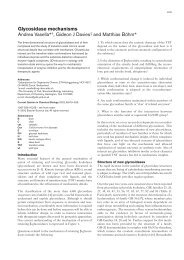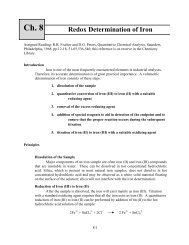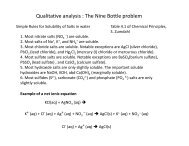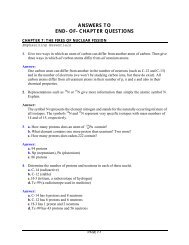ANSWERS TO END-OF-CHAPTER QUESTIONS
ANSWERS TO END-OF-CHAPTER QUESTIONS
ANSWERS TO END-OF-CHAPTER QUESTIONS
You also want an ePaper? Increase the reach of your titles
YUMPU automatically turns print PDFs into web optimized ePapers that Google loves.
55. If all of today’s technology presently based on fossil fuel combustion were replaced by<br />
H2–O2 fuel cells, significantly more H2O would be released into the environment. Is this<br />
effect a concern? Find out what other effects might be anticipated from switching to a<br />
hydrogen economy.<br />
Answer:<br />
While water is not a criteria air pollutant, it is a greenhouse gas. Excess water in the<br />
atmosphere could therefore contribute to global warming. Other effects include the release of<br />
excess CO2 from the hydrogen production, and those listed in 56b below.<br />
56. a. Hydrogen is generally considered as an environmentally friendly fuel, only<br />
producing water after reacting with oxygen. What effect could the widespread use of<br />
hydrogen have on urban air quality?<br />
b. Some scientists are reporting concerns that leakage of hydrogen gas from cars, hydrogen<br />
production plants, and fuel transportation could cause problems in Earth’s ozone layer. How<br />
significant are these concerns? What is the mechanism by which hydrogen could destroy<br />
ozone?<br />
Answer:<br />
a. The widespread use of hydrogen fuel could dramatically improve urban air quality by<br />
reducing levels of particulate matter and SOx produced by internal combustion engines.<br />
b. In June of 2003, geochemists at Caltech created a stir in the scientific community when<br />
they published theoretical models in the journal Science that predicted hydrogen could leak<br />
from production plants, transport systems, and hydrogen-powered cars in the future. They<br />
predicted a large amount of hydrogen would reach the stratosphere assuming all current<br />
fossil fuel combustion was replaced by hydrogen fuel cells and 10-20% of the hydrogen was<br />
lost to leakage. The additional hydrogen in the stratosphere would react and significantly<br />
increase the amount of water molecules found as ice in the stratosphere. Because ozone is<br />
destroyed by reactions with chlorine radicals that take place on stratospheric ice, the<br />
researchers proposed that the rate of ozone destruction would be enhanced. However, other<br />
scientists in academic and industrial research claim the Caltech group’s hydrogen leakage<br />
estimate is too high. One automobile executive argues that the industry would not allow such<br />
a large amount of a valuable commodity (hydrogen) to go to waste. Another scientist points<br />
out that the leaking hydrogen can be recovered. Others use the Caltech group’s research to<br />
support the idea of on-site hydrogen production.<br />
57. At the cutting edge of technology the line between science and science fiction often<br />
blurs. Investigate the “futuristic” idea of putting mirrors in orbit around Earth to focus and<br />
concentrate solar energy for use in generating electricity.<br />
Answer:<br />
Mirrors or lenses could be used to concentrate solar energy on a collection array in space and<br />
send the electricity back to Earth. This technology would counteract one of the major<br />
PAGE 8-20












